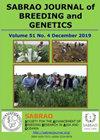ALKALOID ACCUMULATION IN CATHARANTHUS ROSEUS L. IN VITRO CULTURE ENHANCED VIA Ag AND TiO2 NANOPARTICLES
IF 1.7
Q3 PLANT SCIENCES
引用次数: 0
Abstract
Catharanthus roseus L. plant is highly beneficial as chemotherapy drugs due to its rich alkaloids. Nanoparticles (NPs) have served as an abiotic elicitor; therefore, these chemical inputs stimulate various secondary metabolites. The present-day study sought to develop a callus culture and its utilization by applying the NPs to enhance the alkaloids in C. roseus. For callus induction, in vivo, leaves’ inoculation on MS medium had different concentrations of 2,4-Dichlorophenoxyacetic acid (2,4- D), Naphthaleneacetic acid (NAA), and Benzylaminopurine (BAP). After this stage, the induced callus culture gained stimulating by different rates (0, 1, and 2 mg L-1 ) of silver nanoparticles (Ag-NPs) and titanium dioxide nanoparticles (TiO2-NPs). The highest fresh and dry weights of calluses resulted in a combination of 0.5 mg L-1 BAP and 0.5 mg L-1 2,4-D, regarded as the best treatments for callus induction. The study showed no significant effect of NPs on callus growth compared with control. HPLC analysis revealed that field-grown plant leaves had the lowest alkaloid levels compared with elicitorfree callus cultures. However, all NP treatments significantly increased alkaloid contents versus the control. Ag-NPs were more effective than TiO2-NPs in enhancing alkaloid biosynthesis. The highest range of vincristine and catharanthine (0.736 and 1.378 mg g-1 , respectively) emerged with 1 mg L-1 Ag-NPs, while 2 mg L-1 Ag-NPs increased vindoline and vinblastine contents (1.30 and 0.949 mg g-1 , respectively). The control exhibited lower alkaloid contents of vindoline, vincristine, catharanthine, and vinblastine (0.891, 0.492, 0.974, and 0.307 mg g-1 , respectively).Ag和TiO2纳米颗粒增强玫瑰离体培养中生物碱的积累
长春花由于其丰富的生物碱,作为化疗药物具有很高的疗效。纳米粒子(NP)已成为非生物诱导子;因此,这些化学输入刺激了各种次级代谢产物。目前的研究试图通过应用NP来增强玫瑰中的生物碱来开发愈伤组织培养物及其利用。在愈伤组织诱导方面,叶片在MS培养基上接种不同浓度的2,4-二氯苯氧基乙酸(2,4-D)、萘乙酸(NAA)和苄基氨基嘌呤(BAP)。在此阶段之后,诱导的愈伤组织培养通过不同速率(0、1和2mg L-1)的银纳米颗粒(Ag NPs)和二氧化钛纳米颗粒(TiO2 NPs)获得刺激。愈伤组织鲜重和干重最高时,0.5 mg L-1 BAP和0.5 mg L-12,4-D组合被认为是愈伤组织诱导的最佳处理。研究表明,与对照相比,NP对愈伤组织生长没有显著影响。HPLC分析显示,与无诱导子的愈伤组织培养物相比,田间生长的植物叶片具有最低的生物碱水平。然而,与对照相比,所有NP处理都显著增加了生物碱含量。Ag纳米颗粒在促进生物碱生物合成方面比TiO2纳米颗粒更有效。长春新碱和长春花碱的最高范围(分别为0.736和1.378 mg g-1)出现在1 mg L-1的Ag NP中,而2 mg L-1 Ag NP增加了长春花碱和长春碱的含量(分别为1.30和0.949 mg g-1。对照组长春花碱、长春新碱、长春花碱和长春碱的生物碱含量较低(分别为0.891、0.492、0.974和0.307 mg g-1)。
本文章由计算机程序翻译,如有差异,请以英文原文为准。
求助全文
约1分钟内获得全文
求助全文
来源期刊

Sabrao Journal of Breeding and Genetics
农林科学-奶制品与动物科学
CiteScore
1.90
自引率
50.00%
发文量
63
期刊介绍:
The SABRAO Journal of Breeding and Genetics is an international journal of plant breeding and genetics research and was first published in 1969. It is the official publication of the Society for the Advancement of Breeding Research in Asia and Oceania (SABRAO).
Its objectives are to: promote the international exchange of research information on plant breeding and genetics, by describing new research findings, or ideas of a basic or practical nature; and be a medium for the exchange of ideas and news regarding members of the Society.
The Journal gives priority to articles that are of direct relevance to plant breeders and with emphasis on the Asian region. Invited for publication are research articles, short communications, methods, reviews, commentaries, and opinion articles. Scientific contributions are refereed and edited to international standards.
The journal publishes articles for SABRAO members mainly. The Journal preferred strongly that at least one author should be a current member of the Society. Non-members may also publish in the journal.
 求助内容:
求助内容: 应助结果提醒方式:
应助结果提醒方式:


